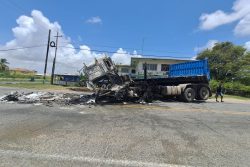(Trinidad Express) The distance between Guyana and Trinidad and Tobago, as well as the route it has to take through Venezuela’s territorial waters, are two major obstacles hindering the construction of a natural gas pipeline to export gas from Guyana to T&T, ExxonMobil’s country manager Alistair Routledge has said.
Exxon has so far discovered over 11 billion barrels of oil (bbo) and 15 trillion cubic feet (tcf) of natural gas in Guyana. T&T currently has an installed capacity to utilise 4.2 billion cubic feet of natural gas per day (bcf/d) but its actual production stands at only 2.5 bcf/d.
Consequently, T&T is urgently seeking alternative sources of supply to address its domestic shortfall, particularly to fuel its LNG and petrochemical plants, and has reached out to Guyana for fuel.
Speaking at a recent energy conference in Houston, USA, Routledge said no decision has been made yet on how Exxon will develop the gas in the southeast portion of the Stabroek Block. However, he admitted that it will be challenging both economically and geographically to transport some of the gas to Trinidad.
“Recognising a pipeline of that length is not necessarily an obvious choice from an economic point of view and indeed when you look at the route taken and some of the territory it needs to pass through. So it’s one of the considerations but certainly not the only one,” Routledge told the conference.
He clarified that Exxon had not ruled out the possibility of T&T’s access to the gas, emphasising that the government of Guyana has been actively encouraging the super major to engage in discussions with T&T in the interest of Caribbean unity.
“I would say there have been discussions, encouraged by the government in Guyana to speak to their neighbours as a keen interest at the Caribbean community level, to have as much collaboration as possible, so that is one of the options that is under consideration,” Routledge said.
“All options have been looked at, including pipeline options to Trinidad, I would say nothing is ruled out today, it’s good news governments are talking to one another and we will see,” he added.
Exxon’s country manager said the company had to fully understand the gas discoveries because it was not dry gas but had a lot of liquids and condensate. Therefore, the right fit will be necessary.
“We have not landed on concepts, we are looking at everything including FPSOs because there will be liquids to handle, and then from there we are looking at what is the right disposition and what markets we can go to, so we might either have to create market opportunities onshore in Guyana or export, and the obvious export is LNG although we have considered other options such as pipelines. That is still in the mix,” Routledge said.
He told the energy conference it may require a base production of one billion standard cubic feet per day (bcf/d) of natural gas.
Routledge said, “ I use the 1 bcf/d just to give an order of magnitude because people have anchored on what we are doing with the gas to energy project and that is a 50 million standard cubic feet (mmscf/d) project and that is clearly very targeted at the local market to provide much-needed power in the country. But to do a larger scale gas development in deepwater we need a much bigger scale which is in order of magnitude a bcf/d. I am not saying that is the right number but it gives you an order of magnitude. Now from there, we have got to obviously have the right offshore facilities to produce, but it is liquids as well as gas,” Routledge ended.










